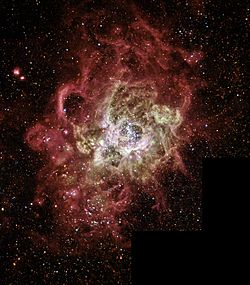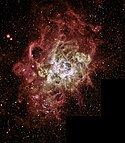NGC 604
| NGC 604 | |
 En infraröd bild av NGC 246 tagen med Spitzerteleskopet. | |
| Observationsdata | |
|---|---|
| Typ | H II region |
| Stjärnbild | Triangeln |
| Rektascension | 01t 34m 33,2s[1] |
| Deklination | 30° 47′ 06″[1] |
| Avstånd | 2,7 (840 kpc)[2] miljoner ljusår |
| Skenbar storlek | 1,93 x 1,2[1] bågminuter |
| Skenbar magnitud | 14,0[1] |
| Fysiska egenskaper | |
| Radie | 760[3] ljusår |
| Absolut magnitud | -13,8 |
| Upptäckt | |
| Upptäcktsår | 11 september 1784 |
| Upptäckare | William Herschel |
| Se även: Nebulosor, Lista över nebulosor | |
NGC 604 är en ovalformad emissionsnebulosa (H II-region) i stjärnbilden Triangeln i M33s nordöstra spets, som är den av M33:s spiralarmar som lyser klarast. Den upptäcktes av William Herschel den 11 september 1784.
Egenskaper

På galaxens uppskattade avstånd på 2,7 miljoner ljusår är den minsta diameter av NGC 604 ungefär 1 520 ljusår (~ 460 parsecs) eller mer än 40 gånger storleken på den synliga delen av Orionnebulosan. Det är över 6 300 gånger mer lysande än Orionnebulosan, och om den var på samma avstånd skulle det överträffa planeten Venus i ljusstyrka. Dess gas joniseras av en hop av massiva stjärnor i centrum med 200 stjärnor av spektraltyp O och WR, en massa av 105 solmassor, och en ålder av 3,5 miljoner år.[2] Till skillnad från det Stora magellanska molnets centralkluster, Tarantelnebulosan, (R136), är NGC 604:s mycket mindre kompakt och mer lik en stor stjärnförening.[4]
Se även
Referenser
- Den här artikeln är helt eller delvis baserad på material från engelskspråkiga Wikipedia, NGC 604, 3 juli 2021.
Noter
- ^ [a b c d] ”NASA/IPAC Extragalactic Database”. Results for NGC 604. http://nedwww.ipac.caltech.edu/. Läst 3 september 2006.
- ^ [a b] Barba, Rodolfo (2004). ”An in-depth analysis of a prototypical giant H II region: NGC 604”. HST Proposal ID #10419: sid. 10419. Bibcode: 2004hst..prop10419B.
- ^ distance × sin( diameter_angle / 2 ) = 760 ly. radius
- ^ Maíz-Apellániz, J.; Pérez, E.; Mas-Hesse, J. M. (2004). ”NGC 604, the Scaled OB Association (SOBA) Prototype. I. Spatial Distribution of the Different Gas Phases and Attenuation by Dust”. The Astronomical Journal 128 (3): sid. 1196–1218. doi:. Bibcode: 2004AJ....128.1196M.
Externa länkar
 Wikimedia Commons har media som rör NGC 604.
Wikimedia Commons har media som rör NGC 604.- Nebula NGC 604 @ SEDS Messier pages
Media som används på denna webbplats
Sternentstehung in NGC604, eine, H-II-Gebiet im Dreiecksnebel (M33), einer Galaxie der lokalen Gruppe. Das ausgeschnittene schwarze Eck kommt von der Geometrie des Detektors in der WFPC2-Kamera des Hubble-Weltraumteleskops
This is a Hubble Space Telescope image (right) of a vast nebula called NGC 604, which lies in the neighboring spiral galaxy M33, located 2.7 million light-years away in the constellation Triangulum.
This is a site where new stars are being born in a spiral arm of the galaxy. Though such nebulae are common in galaxies, this one is particularly large, nearly 1,500 light-years across. The nebula is so vast it is easily seen in ground-based telescopic images (left).
At the heart of NGC 604 are over 200 hot stars, much more massive than our Sun (15 to 60 solar masses). They heat the gaseous walls of the nebula making the gas fluoresce. Their light also highlights the nebula's three-dimensional shape, like a lantern in a cavern. By studying the physical structure of a giant nebula, astronomers may determine how clusters of massive stars affect the evolution of the interstellar medium of the galaxy.
The nebula also yields clues to its star formation history and will improve understanding of the starburst process when a galaxy undergoes a "firestorm" of star formation. The image was taken on January 17, 1995 with Hubble's Wide Field and Planetary Camera 2. Separate exposures were taken in different colors of light to study the physical properties of the hot gas (17,000 degrees Fahrenheit, 10,000 degrees Kelvin

